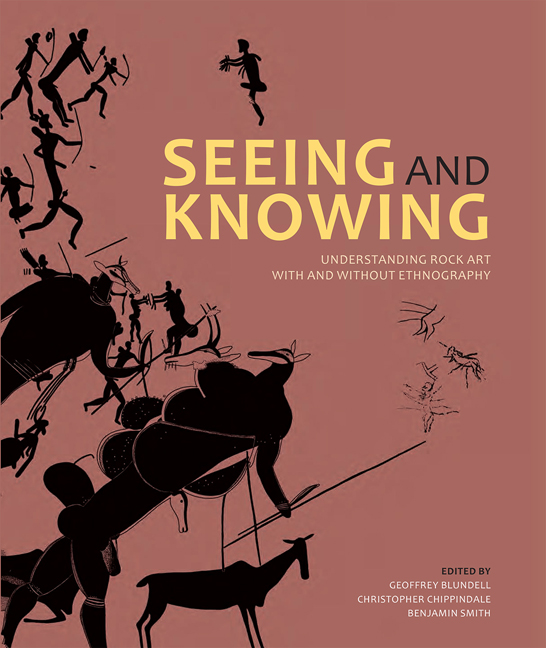Book contents
- Frontmatter
- Dedication
- Contents
- Contributors
- Acronyms
- Chapter 1 Rock art with and without ethnography
- Chapter 2 Flashes of brilliance: San rock paintings of heaven's things
- Chapter 3 Snake and veil: The rock engravings of Driekopseiland, Northern Cape South Africa
- Chapter 4 Cups and saucers: A preliminary investigation of the rock carvings of Tsodilo Hills, northern Botswana
- Chapter 5 Art and authorship in southern African rock art: Examining the Limpopo-Shashe Confluence Area
- Chapter 6 Archaeology, ethnography, and rock art: A modern-day study from Tanzania
- Chapter 7 Art and belief: The ever-changing and the never-changing in the Far west
- Chapter 8 Crow Indian elk love-medicine and rock art in Montana and Wyoming
- Chapter 9 Layer by layer: Precision and accuracy in rock art recording and dating
- Chapter 10 From the tyranny of the figures to the interrelationship between myths, rock art and their surfaces
- Chapter 11 Composite creatures in European Palaeolithic art
- Chapter 12 Thinking strings: On theory, shifts and conceptual issues in the study of Palaeolithic art
- Chapter 13 Rock art without ethnography? A history of attitude to rock art and landscape at Frøysjøen, western norway
- Chapter 14 ‘Meaning cannot rest or stay the same’
- Chapter 15 Manica rock art in contemporary society
- Chapter 16 Oral tradition, ethnography, and the practice of north American archaeology
- Chapter 17 Beyond rock art: Archaeological interpretation and the shamanic frame
- List of figures
- List of tables
- List of publications by david Lewis-williams
- Index
Chapter 5 - Art and authorship in southern African rock art: Examining the Limpopo-Shashe Confluence Area
Published online by Cambridge University Press: 21 April 2018
- Frontmatter
- Dedication
- Contents
- Contributors
- Acronyms
- Chapter 1 Rock art with and without ethnography
- Chapter 2 Flashes of brilliance: San rock paintings of heaven's things
- Chapter 3 Snake and veil: The rock engravings of Driekopseiland, Northern Cape South Africa
- Chapter 4 Cups and saucers: A preliminary investigation of the rock carvings of Tsodilo Hills, northern Botswana
- Chapter 5 Art and authorship in southern African rock art: Examining the Limpopo-Shashe Confluence Area
- Chapter 6 Archaeology, ethnography, and rock art: A modern-day study from Tanzania
- Chapter 7 Art and belief: The ever-changing and the never-changing in the Far west
- Chapter 8 Crow Indian elk love-medicine and rock art in Montana and Wyoming
- Chapter 9 Layer by layer: Precision and accuracy in rock art recording and dating
- Chapter 10 From the tyranny of the figures to the interrelationship between myths, rock art and their surfaces
- Chapter 11 Composite creatures in European Palaeolithic art
- Chapter 12 Thinking strings: On theory, shifts and conceptual issues in the study of Palaeolithic art
- Chapter 13 Rock art without ethnography? A history of attitude to rock art and landscape at Frøysjøen, western norway
- Chapter 14 ‘Meaning cannot rest or stay the same’
- Chapter 15 Manica rock art in contemporary society
- Chapter 16 Oral tradition, ethnography, and the practice of north American archaeology
- Chapter 17 Beyond rock art: Archaeological interpretation and the shamanic frame
- List of figures
- List of tables
- List of publications by david Lewis-williams
- Index
Summary
ROCK ART AND REGIONALITY
In 1925, Samuel Shaw Dornan, an Irish Presbyterian missionary, remarked on Bushman forager rock art: “The paintings are of the same general type all over South Africa. I have seen examples in the Cape Province, Orange Free State, Basutoland, Bechuanaland and Rhodesia, and they all looked the same; one cannot tell from reproductions of these paintings unless one is told where they come from” (1925: 182). It was not until the late 1920s that differences in various parts of the subcontinent were formally recognised; regional bodies of rock art were classified according to differences in stylistic characteristics and other features (e.g. Burkitt 1928; Van Riet Lowe 1952; Willcox 1963a; Malan 1965; Rudner & Rudner 1970; Lewis-Williams 1983; cf. Laue 1999). Today, researchers would not offer general statements such as Dornan's.
With the recognition of regional diversity comes the dual challenge of its explication and explanation. One obvious suggestion is that diversity is an indication of cognitive and cultural differences among the artists (e.g. Lewis-Williams & Dowson 1994: 207; Skotnes 1996: 238). Diversity is, of course, well noted in other aspects of forager culture; ethnographic studies point to the diversity of Khoisan languages and the fluidity of forager religious thought (e.g. Barnard 1992; Guenther 1994, 1999), despite broad similarities. Yet, one needs to guard against any simplistic correlation between material culture and cultural identity (Hodder 1985; Johnson 1999: 98– 101; Hammond-Tooke 2000). Differences in material culture do not necessarily translate into a different cognitive system, and any particular example is likely to be more complex than some archaeological models portray. In southern Africa, a poor chronological understanding of the rock art makes such correlations even more difficult.
Nevertheless, determining more precisely which linguistic group of foragers made what particular cluster of art could allow for the use of more specific ethno - graphy and also for a more nuanced understanding of the diversity of southern African forager rock art than at present.
- Type
- Chapter
- Information
- Seeing and KnowingUnderstanding Rock Art With and Without Ethnography, pp. 74 - 97Publisher: Wits University PressPrint publication year: 2010



